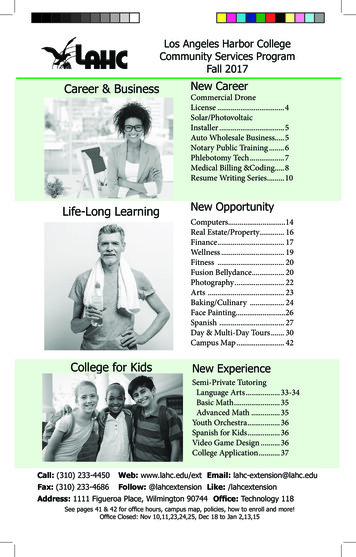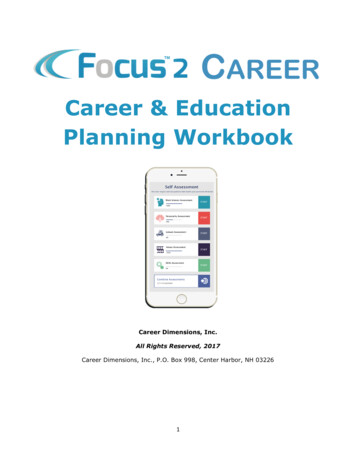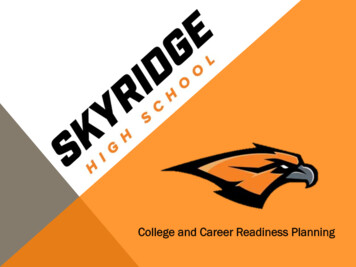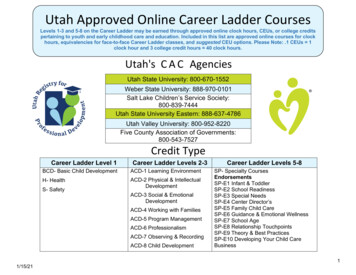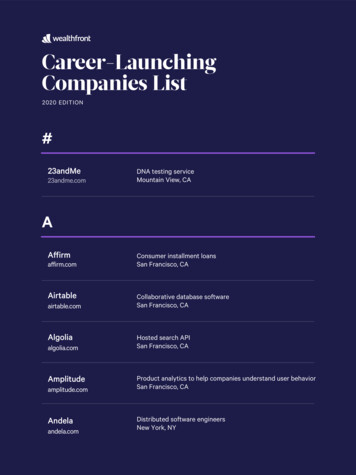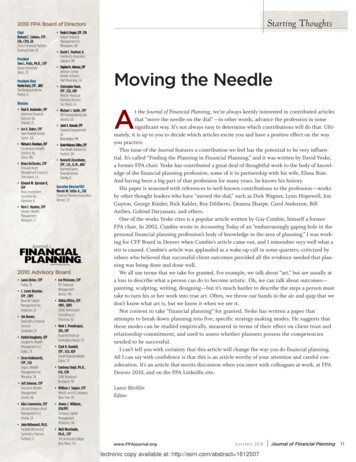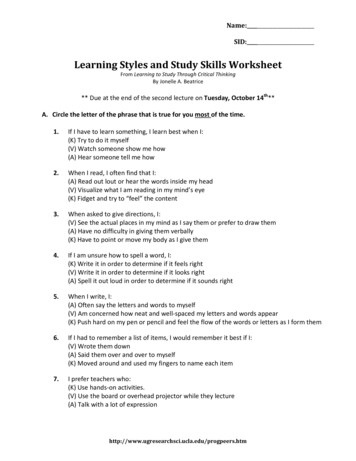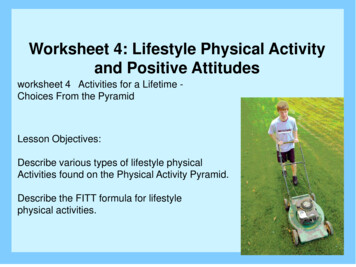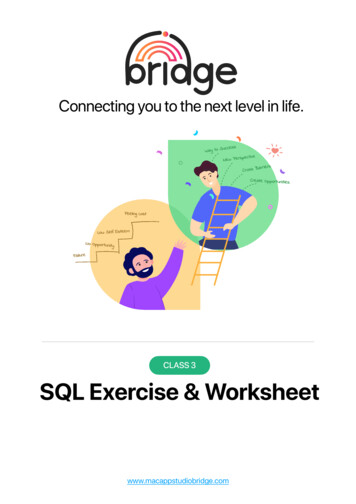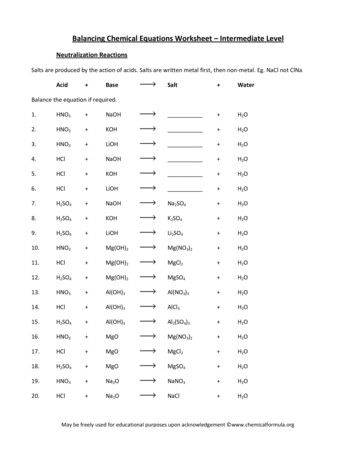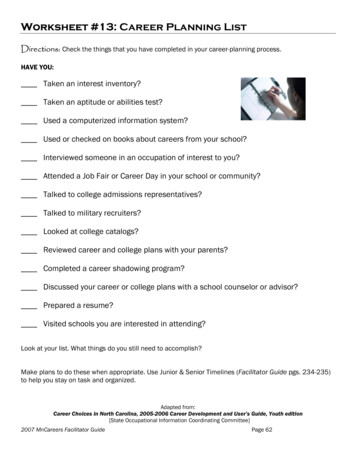
Transcription
Worksheet #13: Career Planning ListDirections: Check the things that you have completed in your career-planning process.HAVE YOU:Taken an interest inventory?Taken an aptitude or abilities test?Used a computerized information system?Used or checked on books about careers from your school?Interviewed someone in an occupation of interest to you?Attended a Job Fair or Career Day in your school or community?Talked to college admissions representatives?Talked to military recruiters?Looked at college catalogs?Reviewed career and college plans with your parents?Completed a career shadowing program?Discussed your career or college plans with a school counselor or advisor?Prepared a resume?Visited schools you are interested in attending?Look at your list. What things do you still need to accomplish?Make plans to do these when appropriate. Use Junior & Senior Timelines (Facilitator Guide pgs. 234-235)to help you stay on task and organized.Adapted from:Career Choices in North Carolina, 2005-2006 Career Development and User’s Guide, Youth edition[State Occupational Information Coordinating Committee]2007 MnCareers Facilitator GuidePage 62
Worksheet #14: Career AlphabetDirections: Write at least one career that starts with each of the following letters (i.e., A astronaut).If you get stuck for answers, check the list of careers in MnCareers or go online.ABCDEFGHIJKLMNOPQRSTUVWXYZCircle 3 careers that reflect your interests and that you would like to learn more about.Adapted from:Career Choices in North Carolina, 2005-2006 Career Development and User’s Guide, Youth edition[State Occupational Information Coordinating Committee]2007 MnCareers Facilitator GuidePage 63
Worksheet #15: Career ResearchDirections: Use information in MnCareers and additional resources to answer these questions about acareer of your choice.Title of Occupation:1. Description of the occupation including main duties and responsibilities.2. What are the education and training requirements for the occupation?3. List other required qualifications such as licensing, certifications, etc.4. What is the average wage or salary for this occupation?5. What is the employment outlook for this occupation?6. List the places where people in this occupation might work.7. What are the opportunities for advancement?8. List other occupations that are similar or related.2007 MnCareers Facilitator GuidePage 64
Worksheet #15, continued9. Is this occupation available in your area? List companies or other places of employment in your area inwhich this occupation is located.10. What school subjects or courses would help you to prepare for this occupation?11. Does this occupation deal mainly with people, data, things or ideas?12. Do you think you have the aptitude (potential ability) for this occupation?13. This occupation interests you because:14. List 3 resources (books, magazines, computerized information, etc.) used for this research.15. List the name and title of a person(s) that helped you locate this information.16. List the name of a person(s) you know (or know of) who is in this occupation.Adapted from:Career Choices in North Carolina, 2005-2006 Career Development and User’s Guide, Youth edition[State Occupational Information Coordinating Committee]2007 MnCareers Facilitator GuidePage 65
Worksheet #16: Nontraditional CareersDirections: Discuss the concepts and implications of nontraditional careers.Definition for Nontraditional Careers: The Department of Labor defines jobs as "nontraditional" if fewerthan 25 percent of the jobs in these occupations are held by one gender. For example, a carpenter,electrician, brick mason and auto mechanic are considered nontraditional occupations for women.Nontraditional CareersFOR WOMENArchitectAuto Body RepairerCarpenterConstruction WorkerDrafterElectronics MechanicOffice Equipment RepairerPolice OfficerPlumber/PipefitterScientistSmall Appliance RepairerSurveyorWelderFOR MENChild Care WorkerCosmetologistDental AssistantDietitianElementary School TeacherFlight AttendantKindergarten TeacherLibrarianLicensed Practical NurseRegistered NurseSecretaryStenographerTelephone OperatorTherapistAdapted from:Career Choices in North Carolina, 2005-2006 Career Development and User’s Guide, Youth edition[State Occupational Information Coordinating Committee]2007 MnCareers Facilitator GuidePage 66
Worksheet #17: Career WomenThis activity is a research project on career women.Directions: From the list below, select a woman and write a paper about her containingthe following information: Find info on her:As resources use:Write:Early lifeEducationCareer highlightsPersonal ough DraftFinal DraftBibliographyAbzug, BellaAngelou, MayaArden, ElizabethAsh, Mary KayBarton, ClaraBattle, KatherineBrothers, JoyceBrown, Helen GurleyBrown, TinaCassatt, MaryChicago, JudyChild, JuliaChung, ConnieClaiborne, LizClinton, HillaryCunningham, MaryCurie, MarieDelaney, LouiseDelaney, BessieDix, DorotheaDole, Elizabeth Dunham, KatherineEarhart, AmeliaEdelman, MarianFields, DeborahFord, EileenFrankenthaler, HelenGibson, AltheaGoodall, JaneGrossinger, JennieHerrera, CarolinaHunter-Gault, CharleneJemison, Mae C.Karan, DonnaKreps, JuanitaLauder, EsteeLeibovitz, AnnieMankiller, WilmaMcClintock, BarbaraMead, MargaretMirabella, GraceMoses, Grandma Nevelson, LouiseNidetch, JeanNoe, DorothyO'Connor, SandraOnassis, JacquelinePopcorn, FaithRide, SallyRoddick, AnitaRubinstein, HelenaRudkin, MargaretSavage, AugustaSills, BeverlyStewart, MarthaVanderbilt, GloriaWalker, Madame C.J.Walker, MaggieWinfrey, OprahAdapted from:Career Choices in North Carolina, 2005-20063 Career Development and User’s Guide, Youth edition[State Occupational Information Coordinating Committee]2007 MnCareers Facilitator GuidePage 67
Worksheet #19: Research Paper on EntrepreneursDirections1. Select a person or company from the list below, or discuss different choices with your teacher.2. Include the following information in your paper: (Sometimes not all of the information is available.)a. Factual data about the entrepreneur: birth date, marital status, children, education.b. Factual data about the company: name, address, telephone number, date the company wasfounded, current revenues, number of employees, amount of the original investment, and thecurrent value of the company.3. Describe the following:a. How the company originated (early experiences)b. How business growth was managedc. How obstacles were overcome4. Relate, if possible, the entrepreneur's:a. "keys to success"b. future visionc. lessons learnedd. inspiring comments 3Com Corp.Apple ComputersAshley FurnitureBill BowermanCrop Genetics InternationalDebbi FieldsFaegre & BensonFarrah GrayFrank D. HickingbothamJames Edgar BroyhillKate SpadeMail Boxes, Etc.McDonald's Corp.Michael BenzingerNetflixOld Country BuffetScott McNealySilicon Graphics, Inc.T.J. CinnamonsThurman John Rodgers Discovery ToysLund Food HoldingsJetBlue AirwaysDick EnricoTCBY Enterprises, Inc.Reed HastingsCurtis L. CarlsonJoyce Rice and Ted RiceH. Wayne HuizengaJoseph R. CanionW. David KimbrellMrs. Fields' Cookies, Inc.Home Depot, Inc.Donald C. BurrMichael DellSeagate Technology, Inc.Robert MetcalfeGotcha Sportswear, Inc.2nd Wind Equipment"Famous Dave" Anderson Nike, Inc.Russell Lund Sr.Compaq Computer Corp.Sun Microsystems, Inc.Blockbuster Entertainment Corp.Steve JobsGlen Ellen Winery and VineyardsCarlson CompaniesWally AmosDavid NeelemanRay KrocL.A. Gear, Inc.Staples, Inc.James H. ClarkBest BuyHome Shopping Network, Inc.Lane NemethDell Computer Corp.Cypress Semiconductor Corp.Alan F. ShugartAdapted from:Career Choices in North Carolina, 2005-2006 Career Development and User’s Guide, Youth edition[State Occupational Information Coordinating Committee]2007 MnCareers Facilitator GuidePage 68
Worksheet #19: Career Informational InterviewDirections: Select someone working in an interesting occupation to interview. Spend at least 20 minutestalking with the individual and gathering information about his or her career and the occupation.Suggested questions are listed below. You can add questions related to your interests and concerns.1. How long have you worked in this occupation?2. What other occupations did you work previously?3. Do you primarily work with people, data, things or ideas?4. What do you like most about your job?5. How did you get started in this line of work?6. What personal qualities do you feel are needed to succeed in this line of work?7. What type of training is needed for this occupation today?8. What changes in your occupation have you seen occur?9. What are the most frequently recurring problems on your job?10. What type of technology do you use? (computer hardware, software, etc.)11.12.13.14.15.Be sure to keep answers in your career portfolio.Adapted from:Career Choices in North Carolina, 2005-2006 Career Development and User’s Guide, Youth edition[State Occupational Information Coordinating Committee]2007 MnCareers Facilitator GuidePage 69
Activity #2o: Skills Scavenger HuntDo you know that workers use the same skills on their jobs as you do in school?Directions: Select someone you know to interview. Ask them the following questionsconcerning skills they use on their job:1. What's your job title?2. What kinds of things do you read?3. What kind of writing do you do?4. Do you communicate by speaking and listening?5. What kinds of mathematics are used on your job?6. Does your company have customers or work with people in different counties, cities, states orcountries? Examples?7. How are major decisions made in your department? Examples:8. Are you a problem solver at work? Could you give an example please?9. What technology do you use to accomplish your job?10. What machines do you operate on your job?11. Do you teach others as part of your job?12. Are you trained in other jobs at the same worksite?13. Where did you learn the skills needed for your job?FOLLOW UP ACTIVITYCombine the results of all the students' interviews into a master list for display. Make one listfor each question and title each sheet with the skill. List the examples the various people toldthe students.*Note for teachers: The objective is for students to explore skills (rather than occupations) ona field trip or shadowing experience.Adapted from:Career Choices in North Carolina, 2005-2006 Career Development and User’s Guide, Youth edition[State Occupational Information Coordinating Committee]2007 MnCareers Facilitator GuidePage 70
Worksheet #21: Career Planning ListThe following is a list of career planning activities. Some of them you might have already work on, whileothers you are just starting. Place a check (9) next to an activity you've accomplished and summarize whatyou learned. Choose 5 activities you have not completed. Use MnCareers and other resources todetermine how you can begin to work on each activity. Be sure to add this information to your portfolio.(9) when completedTook an interest inventoryWhat I learned:Took an aptitude or abilities testWhat I learned:Used a computerized system to researchoccupations & schools (like ISEEK or MCIS)What I learned:Informally interviewed someone in anoccupation I find interestingWhat I learned:Checked out and read books on careersAttended a job fair or career dayWhat I learned:What I learned:Talked to a college admissions representativeReviewed career and educational plan withparents or mentorWhat I learned:What I learned:Talked to a military recruiterWhat I learned:2007 MnCareers Facilitator GuideBrowsed catalogs from higher educationinstitutionsWhat I learned:Page 71
Worksheet #21, continuedCompleted a job shadowing programPrepared a resumeWhat I learned:What I learned:Discussed career and educational plans with aschool counselor or advisorWhat I learned:Used the Internet to search for career andeducational resourcesWhat I learned:Explored different forms of financial aidWhat I learned:Researched different scholarships andgrants to help pay for collegeWhat I learned:Visited schools I’m interested in attendingInterned at an interesting companyWhat I learned:What I learned:What I learned:What I learned:Use this list and expand on your ideas throughout the year. Make sure to check each activity box aftercompleting it and document what you learned. Fill in the 2 blank spaces with additional career-planningactivities not already on the list.2007 MnCareers Facilitator GuidePage 72
Worksheet #22: Where are the Jobs?Use MnCareers to find answers to the questions below.1.Using the table on page 9 in MnCareers, fill in the grid below. In the first column, select 6occupations with a high growth rate. In the second column, list the employment numbers. Next,list growth rate and the median hourly wage.Occupation with HighGrowth RateEmploymentNumbersGrowth RateMedian Hourly Wage%%%%%%2.Categorize the job titles for Minnesota's shrinking occupations from page 9 into the correct careerfields.Agriculture andNatural ResourcesArts and HumanitiesBusiness andAdministrationEngineering andTechnologyHealth ServicesHuman Services3.Based on the table in question 2, which career fields contain the most shrinking occupations?Which fields have fewer expected losses? Give at least one example of why you think these fieldsare changing.2007 MnCareers Facilitator GuidePage 73
Worksheet #22, continued4.Many popular occupations have few openings and applicants face tough competition. Name 5popular occupations that have few openings in Minnesota. Approximately how many openingsdoes each popular occupation have per year? (See page 9 in MnCareers for help.)5.What are the "real" odds of getting hired as a pro athlete? What do these odds tell you aboutpopular occupations in general?6.Many occupations in Minnesota have a large number of openings availa
Career Choices in North Carolina, 2005-2006 Career Development and User’s Guide, Youth edition [State Occupational Information Coordinating Committee] 2007 MnCareers Facilitator Guide Page 71 Worksheet #21: Career Planning List The following is a list of career planning activities. Some of them you might have already work on, while others you are just starting. Place a check (9) next to an .
